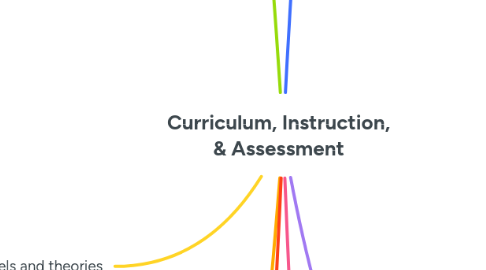
1. Tests outside the classroom
1.1. ACT, SAT, or ASVAB
1.1.1. Taken junior/senior years of high school
1.1.2. Determines university or military eligibility
1.1.3. Standardized test
1.1.3.1. Not indicative of academic success
1.1.3.2. No differentiation
1.1.3.3. Limited alternative testing methods
1.2. Driver’s test
1.2.1. Written and applied skills and knowledge
1.2.2. Theoretical and factual (written) and real-world (vehicle test) assessment
1.3. Job interviews
1.3.1. Mock interviews to prepare
1.3.2. Articulate speech
1.3.3. Proper grammar
1.4. Leveling up or determining proficiency in a sport
1.4.1. Observations to determine preparedness for testing
1.4.2. Specific date goal to achieve level up
1.4.3. Motivate continued education
1.5. Tutoring assessments
1.5.1. Determine learner knowledge and mastery
1.5.2. Guide instruction
1.6. Personality and behavior tests to diagnose medical conditions
1.7. To determine placement in community programs
1.7.1. YMCA swim class
1.7.1.1. Sort by ability, age, and/or size
1.7.1.2. Pair heterogeneous by ability
1.7.2. Trying out for a sports team
1.7.2.1. Ability and/or size
1.7.2.2. Best position placement
1.8. Testing to determine disabilities or disability level
1.8.1. Cognitive testing
1.8.1.1. Autism Spectrum Disorder
1.8.1.2. Speech Disorder
1.8.1.2.1. Physical- tongue issues or lack of practice
1.8.1.2.2. Mental- lack of comprehension
1.8.2. Speech assessment
1.8.2.1. Identify specific impairments
1.8.2.2. Identify interventions based on impairments
2. Assessment models and theories
2.1. Constructivism
2.1.1. PBL (project-based learning)
2.1.1.1. Real-world based
2.1.1.2. authentic
2.1.2. Constructing knowledge collaboratively
2.1.2.1. Peer mentors and grown-ups
2.1.2.2. Vygotsky’s Zone of Proximal Development
2.1.3. Assessments
2.1.3.1. Pretest
2.1.3.1.1. Aligned to standards and learning goals
2.1.3.1.2. Formal
2.1.3.1.3. Baseline for learner progression
2.1.3.2. Formative
2.1.3.2.1. Formal or informal
2.1.3.2.2. Written- individual
2.1.3.2.3. Observation- team
2.1.3.3. Ipsative
2.1.3.3.1. Comparison to previous attempt to determine mastery and trajectory
2.1.3.3.2. Individual
2.1.3.3.3. Formal or informal
2.1.3.4. Summative
2.1.3.4.1. Formal
2.1.3.4.2. Individual or team
2.1.3.4.3. Data to determine if learning goals were met
3. Data, validity, reliability, fairness, & equity, and individual and cultural diversity
3.1. Guide instruction
3.1.1. Differentiation
3.2. Guide instructional best practices
3.2.1. Technology
3.2.2. Peer mentors
3.2.3. Differentiation
3.3. Validity
3.3.1. Is the assessment testing what is being taught?
3.3.2. Thoughtfully and intentionally designed assessments
3.4. Reliability
3.4.1. Can I recreate the results with another sample or population?
3.5. Fairness
3.5.1. Is assessment bias mitigated to provide fair treatment of learners during learning and assessment?
3.5.2. Were all learners given access to the same resources, instructional practices, and differentiation?
3.6. Equity
3.6.1. Are the assessments, resources, and instruction accessible to all learners?
4. Current thinking about the role of grading and its impact on learning
4.1. Best curriculum for learners
4.2. Instructional best practices
4.3. Aligning assessments with curriculum
4.4. Ensuring access to curriculum, resources, and best instructional practices
4.5. Creating meaningful, intentional, and authentic assessments
4.5.1. Guide instruction
4.5.2. Guide instructional best practices
4.5.3. Identify learning gaps
4.5.4. Establish and adjust learner trajectory
4.6. Ensure validity, reliability, fairness, and equity in all aspects of assessment
4.7. Learner partners in assessment development
5. Assessment models and application
5.1. PBL (project-based learning)
5.2. Constructing knowledge collaboratively
5.2.1. Peer mentors and grown-ups
5.2.2. Vygotsky’s Zone of Proximal Development
5.3. Assessments
5.3.1. Pretest
5.3.1.1. What are the learning goals?
5.3.1.2. What does the learner know?
5.3.1.3. What does the learner need to know to effectively complete the project?
5.3.1.4. What is the learner’s academic trajectory?
5.3.1.5. Groups based on learners’ strengths, weaknesses, and learning gaps
5.3.2. Formative
5.3.2.1. Has the learner’s knowledge advanced during the project?
5.3.2.2. Does the learning trajectory need to be adjusted?
5.3.2.3. Quiz (formal)
5.3.2.4. Exit ticket (informal)
5.3.2.5. Appropriate learning milestones reached
5.3.2.6. Anecdotal notes
5.3.3. Ipsative
5.3.3.1. How did the learner do compared to the previous assessment?
5.3.3.2. Team or individual based
5.3.3.3. Formal or informal
5.3.3.4. Appropriate learning milestones reached
5.3.3.5. Anecdotal notes
5.3.4. Summative
5.3.4.1. Did the learner reach the project’s goals?
5.3.4.2. Where are the learning gaps?
5.3.4.3. Team or individual based
5.3.4.4. Formal or informal
5.3.4.5. Appropriate learning milestones reached
5.3.4.6. Anecdotal notes
6. Test types
6.1. Pretest
6.1.1. standards aligned
6.1.2. guide instructional practices
6.1.3. Formal or informal
6.1.3.1. Open-ended questions during bellringer or hook during lesson introduction (informal)
6.1.3.2. Quarter 1 diagnostic (formal)
6.1.3.3. Preschool screening (formal)
6.1.4. curriculum aligned
6.1.5. meaningful
6.1.6. authentic
6.1.7. Learner partners in assessment development
6.1.8. establish baseline for learner knowledge and learning trajectory
6.2. Formative
6.2.1. Continues guiding instructional practices
6.2.2. Continues guiding instruction
6.2.2.1. Assesses learner mastery
6.2.2.2. Determines areas that need reteaching or intense intervention
6.2.3. Steers the course for a learner’s academic trajectory
6.2.3.1. Allow for alternative testing methods
6.2.3.2. Differentiated
6.2.4. Formal or informal
6.2.4.1. Unit test (formal)
6.2.4.2. Open-ended questions during a lesson (informal)
6.2.4.3. Exit ticket (written or verbal) (informal or formal)
6.2.5. Learners partner in assessment development
6.3. Summative
6.3.1. Determines efficacy of instructional practices
6.3.2. Determines learner mastery
6.3.2.1. Determines areas that need reteaching or intense intervention
6.3.3. Formal
6.3.3.1. Benchmark
6.3.3.2. Midterm exam
6.3.3.3. ACT or SAT
6.3.4. Continues steering the course for a learner’s academic trajectory
6.3.4.1. Remedial, AP, or dual enrollment classes
6.3.4.2. Differentiated
6.3.4.3. Allow for alternative testing methods
6.3.5. Learners partners in assessment development
